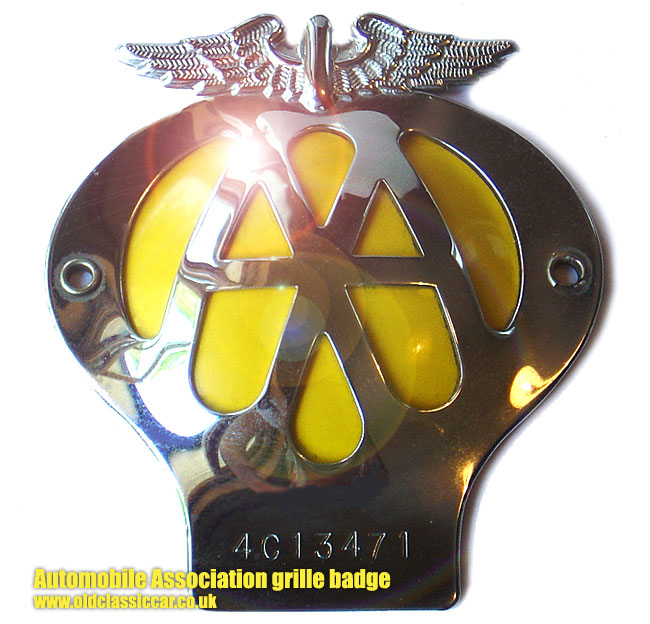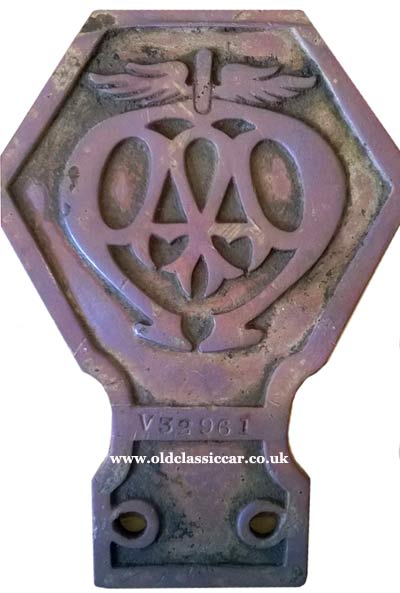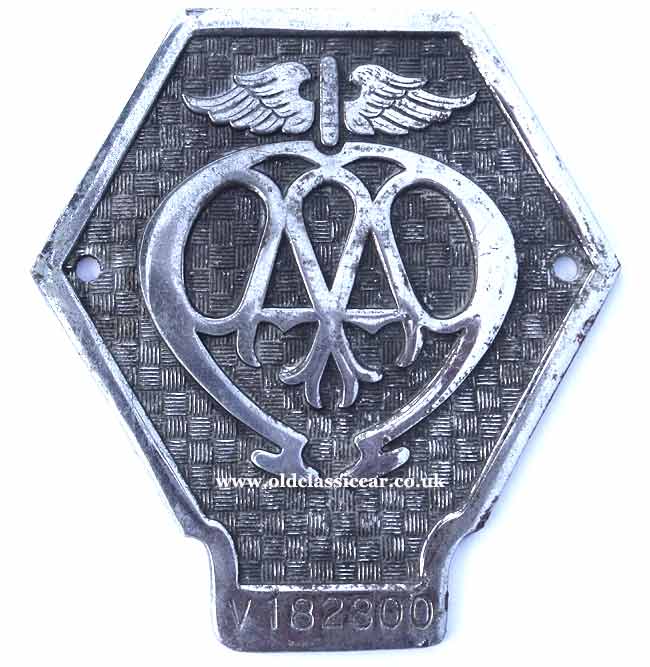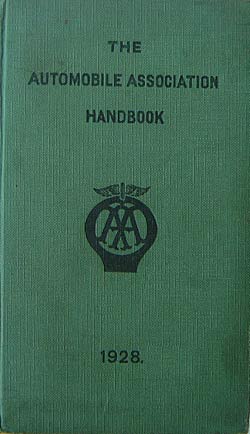AA Car Badges, and other collectables.
2006 was the 100th year of Automobile Association (AA) car badges, the first ones being issued to members way back in 1906, when motoring was very much in its infancy.
|

|
|
There are lots of old badges still in circulation, some in good condition like the one shown above, and other badges needing a fair bit of restoration. The shape and style varied throughout the years, with special versions being available to motorcyclists and lorry drivers.
|
How to date an AA badge.
Badges are stamped up with issue numbers on them, the table below gives an indication of when a particular
badge was sent out:
- 1 to 999,999 - 1906-30
- A-P suffixes - 1930-45
- RST suffixes - 1946-56 (Flat motorcycle badges)
- WXYZA suffixes - 1956-67 (Domed motorcycle badges)
- OA to OZ prefixes - 1945-57
- 1A-9A prefix - 1957-59
- 1B-9B prefix - 1960-61
- 1C-9C prefix - 1962-63
- 1D-9D prefix - 1964-65
- 1E-9E prefix - 1966-67
The badge in the photograph above therefore dates to sometime between 1962 - 1963, being a 4C coded example. The most common AA badges still in circulation, and most likely to be fitted to a badge bar on a classic car, are the domed examples, which first came out in 1945. Owners of cars built from 1967 onwards should really look out for the later square badges, if they want to be 100% accurate. More information on the history of the AA can be found on the AA's website.
|
Early AA badge (1906 type) - help please.
The following badge I've been researching for a little while, on and off. It belonged to the father of OCC visitor Julie Gilchrist, her father was an AA patrolman named Ron Whitworth. Julie adds: "He joined the AA in 1957 and started out on the motorbikes and then moved onto the vans, he worked in the West Sussex area. He frequently attended such events as Goodwood Races to provide assistance to any members there. He had the privilege to be invited to form part of the guard of honour for the Queen when she opened the new AA headquarters at Basingstoke, one of the only two chosen from West Sussex. He received several letters of commendations during his career with the AA for his efforts to get vehicles moving again. He retired from the AA in 1990, having served for 33 years".
|
|
The very first badges from March/April 1906 looked like the following example. This was at the time before the AA merged with the Motor Union, after which (1911-on) the "wings" began to feature on the top of the members' badges. The first badges simply had the AA founder's signature on them, Stenson Cooke, followed by the member's membership number. After a very short while, the words "Secretary" were added beneath Cooke's name. The badge shown below has a very early number engraved upon it, 355, with no mention of Secretary. According to "Golden Milestone" (published by the AA in 1955), membership by June 1906 had exceeded 900, while at year's end it was nearly 3000. *If* this badge is correct, it would date therefore to April or May, approximately. By the end of 1906, the AA's telephone number and telegraphic address were inscribed on the reverse side of the badges (neither of which are on this badge).
|
|
The first batch of badges was produced by a firm called Nash & Hull, but from December 1906 onwards production transferred to Walter Rowley Ltd of Birmingham, who continued in the role for the next 60 years. Two versions were produced, one in brass, the other in chrome-over-brass. The badge below was plated at some point, but this has been sanded off at an unknown time to reveal the brass beneath, apart from on the edges where chrome is still visible. The brass is well polished, although my scanner doesn't really show it well.
|

|
|
Apparently, the first 100 (maybe more?) badges in 1906 were hand cut. Looking at the badge shown here, it too appears to be hand cut as the details aren't as well defined as on later, 1906/07/08, examples. I cannot decide whether it's a very early example, or a slightly later reproduction - although I would imagine that a reproduction would be mass-produced and not hand-made, as this one appears to be (the AA themselves produced one reproduction in the 1930s, and a series of them in 1955 stamped with "1905-1955"). The engraved script on this badge certainly looks very early, differing slightly to that which I've seen on higher-numbered, 1906/1907, badges. It measures 5.5 inches tall.
|
|
I'd love to know more about this badge, if anyone reading this can help. It came from a former AA patrol man of many years standing, but where it came from before that isn't known. Is it original from 1906, or a slightly later hand-cut reproduction, to which old script has been engraved? Would AA records go back as far as member number 355 to shed light on who it may have belonged to, if original? I have a slim Shire book on the subject of AA memorabilia, but I see that a larger book was also published on the subject of AA badges a few years ago - "British Car Badges : The Complete Guide to the AA and RAC, Their Affiliates and Competitors". Does anyone have a copy they could check for me please?
|
More badges.
Many different styles of badges were produced over the years, depending on the era, the vehicle they were destined to be fitted to, and the country they would be dispatched to - South Africa, for example, had its own variation on the theme. Below are several of the less-commonly encountered versions, others will be added later.
|
|
The next example was dug up in a field by a visitor to OCC, after locating it with a metal detector. It has a V prefix, its full number is V32961, and is the earliest example to feature on this page. The outer edges of the badge were cropped off in the photo I received. It's worth noting the relative lack of detail to be found in the casting. I've a feeling this may be an early commercial vehicle badge, of a type produced from 1911 to about 1930.
|

|
Another "field-find" AA badge.
Amazingly, in 2018 I received an email containing news of another badge, of the same style as the one shown above, that had also been dug up in a field. Quite a coincidence. More amazingly though was that the unique membership number stamped upon this latest find, is just 6 further on from that shown on the previous example. The 'new' AA badge find is numbered V32967, and was found on church land.
|

|
|
Badge number 56387L, shown below, was found beneath the seat of a car I own. Unlike some, this badge - a pre-war example - is flat and quite lightweight, but features a reasonable amount of detail to the winged wheel at the top.
|

|
|
Motorcyclists and lorry drivers had their own variants of the badge. Next is a chrome commercial vehicle badge, numbered V182800. This will be fitted to a lorry of my own. This style of lorry badge, with the basket weave background, was introduced at the beginning of the 1930s.
|

|
AA books and handbooks.
Many people collect badges, books, signs and other items relating to the AA. Handbooks are very popular items to hunt down, and usually don't cost much money, other than for the earliest examples that would command a premium. I always try to have the correct year's AA handbook casually sat on the back seat, or glove tray, of my old cars. They turn up in old bookshops, car boot sales, and regularly show up in online auctions.
|
 |
AA Handbook 1966/1967.
Some handbooks were hardback, others, like this Members Handbook from 1966, are a softback publication, in this case featuring an AA Patrol Austin Minivan on the cover. 254 FGN was probably photographed on one of the new(ish) fangled motorways that had been springing up across the UK.
Information given included the newest road signs, intelligent driving techniques, first aid advice, appointed AA garage locations, and pointers to diagnose problems yourself. AA hotels and various road maps also featured extensively.
Interesting is the section on courtesy to those around you - recommending that you don't go around blaring horns, screeching tyres, slamming doors and bootlids, especially at night. A few people could do with reading this section!
|
 |
AA Handbook 1928.
Flipping back to the late 1920s and the keen motorist would no doubt have this handbook nestled in his dashboard cubby hole. Similar information to the later editions is included in this one, including a handy (slightly confusing) car tax table in the opening pages. Car tax could be purchased throughout the year, with an end-date of December 31st. Once you'd decided on the period of tax you needed, you go down the table, til you found the row for your vehicle's Horse Power rating (a system devised I think by the RAC ironically), and work your way across to find your car's tax rate.
Some great photographs of AA patrol vehicles also feature, including a motorcycle and sidecar combination (converted to carry tools rather than the mother in law). Two variants were in their fleet - the AA "Road Service Outfit" and the AA "Night Road Service Outfit", the latter apparently painted in brighter colours and with extra lamps by the look of it. Roadside telephones, the AA Fog Flare, the Super Telephone Box, and examples of AA road signs are also featured.
|
 |
This Motoring, Stenson Cooke, pub. 1931.
This book was published a few times, although most seem to be the later softback version rather than this hardback book, with dust jacket, that came out in '31.
The full title is "This Motoring - The Romantic Story of the AA". The notes inside the jacket sum up the book .. "This Motoring is a simple, human story of the World's largest Motoring Organisation, told by the man who saw it grow from ninety to over four hundred and thirty thousand members, all in twenty-five vivid years. Every motorist should read how it was done".
|
|
|
[return to the Motoring Miscellanea section]
|
|
An interesting old photo, of an AA patrol man and his motorcycle with sidecar combination, can be seen here in the vintage motoring photos section. While here I look at a leaflet issued by the AA in 1952 regarding safe and courteous motoring, illustrated with a selection of excellent cartoons.
|










